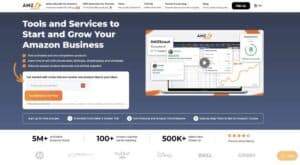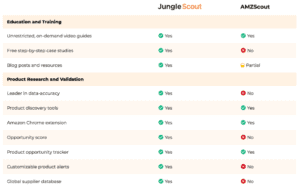Helium 10 Tutorial for Beginners
Learn how to navigate and use Helium 10’s tools effectively as a beginner Amazon seller to streamline product research, listing optimization, and sales growth.
For new Amazon sellers, Helium 10 can be a game-changer, offering a suite of tools designed to improve every aspect of selling on Amazon. However, with so many features available, it can feel overwhelming at first. This tutorial will walk you through essential Helium 10 tools, helping you understand how to start and how each tool can make your Amazon business more profitable and efficient.
Getting Started with Helium 10
Setting Up Your Helium 10 Account
- Sign Up: Visit Helium 10’s website, choose a plan that fits your budget and needs, and complete the signup process.
- Explore the Dashboard: Helium 10’s dashboard is the control center for all tools. Familiarize yourself with the layout and where each tool is located.
- Select Key Tools: Start with the most essential tools, focusing on product research, keyword optimization, and listing improvement.
Why Helium 10 is Perfect for Beginners
Helium 10 provides an all-in-one platform, eliminating the need for multiple subscriptions. Its tools cater to beginners with intuitive interfaces and tutorials. Additionally, Helium 10’s tools simplify Amazon-specific tasks, such as finding profitable products and optimizing listings.
Essential Helium 10 Tools for New Amazon Sellers
1. Black Box: Your Product Research Hub
- How It Works: Black Box enables you to search for products based on monthly revenue, review count, competition level, and more.
- How to Use It as a Beginner: Set parameters like a low review count and steady revenue to identify products with lower competition. This helps beginners find viable entry points into competitive markets.
- Pro Tip: Experiment with different filters until you identify profitable niches with manageable competition.
2. Xray: Analyzing Product Viability
- How It Works: Xray is a Chrome extension that provides real-time insights on products, including sales estimates, price history, and review analysis.
- How to Use It as a Beginner: Open Xray while browsing Amazon to view data for specific products, helping you make informed choices before investing.
- Pro Tip: Use Xray to compare multiple products within a niche to determine which has the best potential for long-term success.
3. Cerebro: Keyword Research Simplified
- How It Works: Cerebro allows you to perform reverse ASIN lookups to see which keywords competitors are ranking for.
- How to Use It as a Beginner: Enter a competitor’s ASIN to gather high-traffic keywords and use them in your product listings to improve visibility.
- Pro Tip: Start with primary, high-traffic keywords, then add secondary terms to capture broader search intent.
4. Magnet: Discover New Keywords for Your Listings
- How It Works: Magnet generates keyword suggestions based on search volume and relevancy scores, making it easier to expand your keyword list.
- How to Use It as a Beginner: Begin with a seed keyword related to your product, and Magnet will generate relevant keywords to include in your listing.
- Pro Tip: Prioritize high-relevancy keywords for titles and bullets, then add other relevant keywords in the product description.
5. Scribbles: Optimizing Your Product Listing
- How It Works: Scribbles is a listing editor that helps you integrate keywords into your listing content.
- How to Use It as a Beginner: Input your keywords, then organize them across titles, bullet points, and descriptions to ensure they’re used effectively.
- Pro Tip: Aim to create an engaging title with primary keywords upfront, followed by benefit-focused bullet points.
Step-by-Step Guide to Setting Up Your First Product on Helium 10
Step 1: Product Discovery with Black Box
- Use Black Box to identify products with consistent demand and manageable competition.
- Look for products in niches that align with your goals, like high demand and low competition.
Step 2: Evaluate Product Potential with Xray
- Use Xray to analyze products you found in Black Box. Focus on sales volume, review count, and price trends to understand potential profitability.
- Shortlist products that meet your criteria and perform well on Amazon.
Step 3: Conduct Keyword Research with Cerebro and Magnet
- Use Cerebro on top competitors to understand which keywords drive traffic to their listings.
- Follow up with Magnet to generate additional keywords. Create a comprehensive list and organize keywords by search volume and relevance.
Step 4: Optimize Your Listing with Scribbles
- Transfer the most important keywords into Scribbles, and start creating your listing. Ensure keywords are incorporated naturally across all listing elements.
- Focus on crafting a clear, keyword-rich title and concise bullet points that emphasize product benefits.
Step 5: Validate Keywords with Index Checker
- Once your listing is complete, use Index Checker to ensure all primary keywords are indexed by Amazon.
- Regularly monitor your listing to ensure keywords remain indexed, especially after edits.
Tips for Success Using Helium 10 as a Beginner
Start Small, Scale Strategically
- Begin by listing one or two products, focusing on niches you’re familiar with. Scaling too quickly can lead to operational challenges, especially for new sellers.
Prioritize Listing Optimization
- Take the time to create well-optimized listings from the beginning. A properly optimized listing will help you gain traction faster and compete more effectively.
Utilize Helium 10’s Educational Resources
- Helium 10 offers tutorials, webinars, and support resources that can make learning the platform easier. Invest time in learning the tools fully to maximize their benefits.
Monitor and Adjust Regularly
- Use Helium 10’s analytics to track performance and adjust keywords, pricing, and other listing aspects based on data insights.
Conclusion
Helium 10 provides essential tools that make Amazon selling more accessible and strategic. By following these steps and using Helium 10’s beginner-friendly tools, new sellers can gain confidence and build a solid foundation for their Amazon business.
FAQs
Is Helium 10 suitable for beginners?
Yes, Helium 10’s intuitive interface and beginner-friendly tools like Black Box and Scribbles make it an excellent choice for new Amazon sellers.
Which Helium 10 tool is best for finding profitable products?
Black Box is ideal for product research, allowing sellers to filter products based on revenue, competition, and reviews.
How can Helium 10 help with keyword research?
Helium 10’s Cerebro and Magnet tools provide comprehensive keyword insights, helping sellers find high-traffic keywords to optimize listings.
What is Index Checker, and why should beginners use it?
Index Checker confirms whether keywords are indexed by Amazon, ensuring that listings appear in relevant search results.
How does Xray improve product selection?
Xray provides real-time data on product performance, helping beginners assess potential profitability and make more informed product choices.
Top Tools to Simplify and Scale Your Business
- Helium 10: Amazon seller suite with beginner-friendly tools for product research, listing optimization, and keyword management.
- Jungle Scout: Simple product research and market insights for new sellers.
- Viral Launch: Offers advanced analytics and insights for scaling Amazon businesses.
- FeedbackWhiz: Email automation and review management to help build a positive brand reputation on Amazon.
- Zoho CRM: Customer management tool with integrations for tracking and scaling Amazon sales.
- HubSpot: CRM and marketing automation that supports Amazon-related customer outreach.
- AMZScout: Alternative to Helium 10 and Jungle Scout, focusing on product research and niche analysis.
Keywords: Helium 10 tutorial, Amazon seller tools, product research, listing optimization, keyword research, beginner guide, Helium 10 for beginners, Amazon SEO, keyword indexing, Amazon analytics







